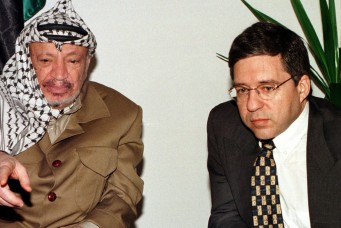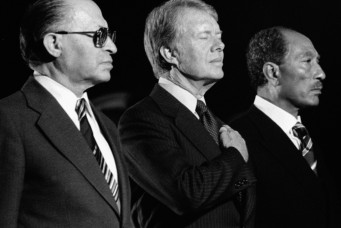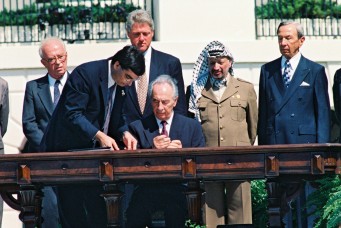The Oslo Accords: A Closer Look
Former Palestinian foreign minister Nasser Alkidwa takes a closer look at the strengths and weaknesses of the Oslo Accords, the lessons learned, and the way forward

The main concept behind the Oslo Accords (the 1993 Declaration of Principles and ensuing agreements) between the Palestine Liberation Organization (PLO) and the government of Israel was to establish a framework of transitional self-governing arrangements for Palestinians in the West Bank and Gaza Strip over a five-year period. The agreement stipulated that negotiations on a permanent solution would commence in no more than three years.
The concept behind Oslo had its origins in the 1978 “Framework for Peace in the Middle East,” one of the primary documents of the Camp David Accords, signed in Camp David by Egyptian President Anwar Sadat and Israeli Prime Minister Menachem Begin and brokered by U.S. President Jimmy Carter. Since then, this idea has been the basis of Israeli and U.S. policies and the cornerstone of the numerous peace initiatives that followed, adding or diluting some aspects or provisions depending on the prevailing circumstances.
Different Initiatives, Same Concept
The fundamental deficiency of the 1978 “framework” document was that it did not guarantee the Palestinian people their inalienable rights of self-determination and national independence. Nor did it acknowledge the reality of the Israeli occupation or the need to end it. Moreover, it did not define a final outcome, leaving the matter to Israel—the stronger party.
The framework clearly stipulated full autonomy for the people and negotiations on the final status of the West Bank and the Gaza Strip based on United Nations Resolution 242. However, its main weakness was in its failure to recognize the Palestinian people’s political and popular representatives. The legitimate rights and just needs of the Palestinian people were mentioned, but the agreement as a whole specified only the residents of the West Bank and the Gaza Strip. Essentially, negotiations in both stages were delegated to Egypt and Jordan with Palestinian participation. The document was categorically rejected by the Palestinian side as well as by the Arab states in general.
In 1982, in the aftermath and perhaps because of the Israeli invasion of Lebanon, U.S. President Ronald Reagan introduced a peace initiative that would bear his name—“the Reagan Plan.” It stipulated a five-year transitional period of autonomous arrangements for the West Bank and the Gaza Strip and negotiations on the final settlement on the basis of UN Resolution 242, in all aspects. Using the same language as the Framework for Middle East Peace, Reagan acknowledged his administration’s commitment to its provisions. He also called for a freeze on settlements and affirmed that the United States would not support Israel’s permanent control of the West Bank and Gaza Strip but would support a Palestinian confederation with Jordan, while opposing the establishment of a Palestinian state. Against dividing Jerusalem, Reagan called for the status of the city to be negotiated between both parties. While the Palestinian and Arab sides did not accept Reagan’s proposal, the Israelis vehemently rejected the initiative.
In another instance, following the 1991 Gulf War, the United States called for the convening of the Madrid Middle East Peace Conference, hosted by Spain and co-chaired by U.S. President George H. W. Bush and Russian President Mikhail Gorbachev, to facilitate direct negotiations between Israel and the Arab countries, and Israel and the Palestinians as part of a joint Jordanian–Palestinian delegation. The negotiations proceeded on both bilateral and multilateral tracks, with broad Arab and international participation. The letter of invitation to the Madrid Conference reiterated the same central concept as the Camp David framework, but diluted the language on the establishment of Palestinian five-year self-governing arrangements and negotiations toward a permanent solution by the third year.
Madrid also provided one year to reach agreement on issues governing the five-year period. However, Palestinian participation in the delegation did not include official PLO representation and was limited to residents of the West Bank and the Gaza Strip, excluding Jerusalem. There was no mention of the Palestinian people nor their legitimate or political rights. The PLO accepted this highly watered-down version of the core concept and provided political cover for Palestinian participation in the joint Jordanian–Palestinian delegation. This position not only reflected Palestinian isolation, but also Palestine’s deteriorating relationship with Arab countries following the 1991 Gulf War, along with the collapse of the Socialist Bloc and the Soviet Union that radically altered the balance of power.
One Step Forward, Many Steps Back
In 1993, a secret channel was established in Oslo between the government of Israel and the PLO. This dialogue led to the exchange of “Letters of Mutual Recognition” between Israel and the PLO, by which the PLO recognized Israel’s right to exist in peace and security, and the Israeli government recognized the PLO as the representative of the Palestinian people. The Oslo Accords were a continuation of the same formula: autonomous arrangements for five years followed by negotiations on a permanent solution no later than the third year. The parties also agreed to commence with Gaza and Jericho, prior to the election of the Palestinian Authority (PA).
Although the Oslo Accords carried the same fundamental deficiency as in the initiatives mentioned above, the Declaration of Principles improved on Madrid in that Israel recognized Palestinian legitimate and political rights and their rightful demands as well as declared its willingness to negotiate with the PLO. Moreover, Israel accepted certain issues as subject to final status negotiations, including Jerusalem and refugees. It also accepted the participation of Palestinian Jerusalemites in the elections of the Palestinian Legislative Council, an indication that the final status of Jerusalem would be subject to negotiations. Moreover, a letter sent by Foreign Minister Shimon Peres to Norwegian Foreign Minister Johan Jørgen Holst on October 11, 1993, confirmed that Israel would preserve the Palestinian institutions in Jerusalem. Overall, the accords implied a positive outcome that would culminate in the recognition of a Palestinian entity, and probably a Palestinian state, assuming Israel’s good intentions.
Nonetheless, the provisions of the accords fell short, even in comparison to the Framework for Peace in the Middle East which stipulated full autonomy, and not arrangements for self-government. The text was muddled and ambiguous in many places, especially with regard to withdrawals, relocations, and transfer of powers. One of its most glaring problems was its failure to stipulate freezing settlements, as called for in the Reagan initiative.
Herein lies the discrepancy between the political will of the Palestinian leadership, which was determined to establish a state, and the professional and technical abilities of Palestinians in the fields of negotiations and deliberations. While the Palestinian leadership was able to make progress on aspects that were not originally in the agreement, such as changing the name of the PA and modeling its institutions on three branches of governance (executive, legislative, and judicial)—as well as building an airport in Gaza, and returning all Palestinian leaders and many Palestinians in the diaspora—on the professional and technical levels, many steps backward were taken with each new agreement.
An example of backpedaling in the negotiations is the contradiction between the provisions of the Declaration of Principles on the issue of the Palestinian Authority’s mandate and the ensuing division of the West Bank and Gaza Strip into Areas A, B, and C in later agreements. The text of the declaration stipulated that the mandate of the Palestinian Legislative Council include the West Bank and the Gaza Strip, except for final status issues such as settlements and the positioning of the Israeli army. In subsequent agreements, however, Israel became responsible for all areas, whether for security and civil administration (Area C) or only security (Area B), with the general exception of the Palestinian residential centers (Area A). Another significant example is the 1994 Paris Protocol (on Economic Relations) that recognized Israel’s full domination over Palestinian economic life.
Opposition and Repercussions
The discrepancies between the general political meanings and the details of the agreements, and the gap between the political will of both parties, led to an ongoing confrontation, even during times when Israel’s intentions of implementing the accords were good. However, opponents on both sides attempted to thwart the agreements with violent attacks, starting with the Ibrahimi Mosque (Cave of the Patriarchs) massacre by settler Baruch Goldstein in 1994, and the bombing attacks against Israeli targets that seemed intended to stifle the PA and the agreements.
It also became clear that the Israeli right wing—which grew stronger with each attack—was pushing to reverse the Oslo Accords and revert to the idea of “Greater Israel” that denies the existence of a Palestinian people. The assassination of Yitzhak Rabin in November 1995 was a brutal expression of increasing Israeli popular and institutional opposition to the accords and a blow to the entire peace process as the five-year period ended with no real change. After Rabin’s assassination, the situation in the Occupied Palestinian Territory drastically deteriorated, in flagrant disregard of the Oslo Accords.
Israel reoccupied areas under PA control, destroyed infrastructure and bodies of the authority, including the security apparatus; the Israeli army besieged President Yasser Arafat in his headquarters, leading to his assassination; Israel unilaterally withdrew from Gaza, ignored Hamas’s takeover, leading to the separation of the Gaza Strip from the West Bank. Also, Israel rapidly increased settlement building—the settler population is now at 800,000 compared with 200,000 when the accords were signed; the Judaization of Jerusalem escalated, amid efforts to end official and popular Palestinian presence in the city; the Israeli military government and civil administration were re-established, under the designation of the Coordinator of Government Activities in the Territories; and Israel took full control of Al-Karamah border crossing with Jordan, and attempted to alter the legal and legislative framework of the West Bank and to impose Israeli law on settlements.
With all these developments, the Oslo Accords have practically ended. In reality, and for some time, the parties have behaved as if the accords do not apply but stop short of actually announcing that. Israel does not attempt to feign reconciling its policies and measures with the accords, which many Israeli officials have been vocal about ending while proposing alternative strategies. For its part, Palestine has boosted its international efforts toward legitimizing the legal status of the state of Palestine and has raised the level of its grievances against Israel at international forums. Although the United States, since the George W. Bush administration, had been referring to a Palestinian state and resolving final status issues, the Donald Trump administration has recently taken steps regarding Jerusalem, refugees, and the PLO, signifying the United States’ complete disregard for the Oslo Accords.
In refraining from announcing the accords’ failure or termination, none of the parties are then obliged to bear the legal or political responsibility resulting from such an official declaration. For Israel, it appears logical to retain what practically remains from the accords, namely a largely weakened Palestinian Authority with minimal powers, whose security apparatus and cooperation with Israel are of primary importance. For the Palestinians, giving up on the authority, despite all of its shortcomings, is difficult for many reasons, the most important being its responsibility toward the Palestinian people of the West Bank and the Gaza Strip.
An Alternative Palestinian Strategy
Perhaps the most important lesson learned from the accords is the need to reject any transitional solution that leaves the permanent solution undetermined. The outcome of the final resolution must first be defined, even if it entails implementation over several stages. The second lesson is the necessity to reject the U.S. monopoly on mediating the process, as it does not comply with international law and legitimacy. International responsibility and a broader international mechanism that would guarantee the minimum level of impartiality must be ensured.
At this point, any successful Palestinian strategy should include strict adherence to the existence of the state of Palestine on the 1967 borders with East Jerusalem as its capital, the common national goal of which is to achieve national independence for Palestine and not establish a Palestinian state, which already exists. It should also include resistance, cessation, and reversal of settler colonialism in the land of Palestine as the intrinsic threat to Palestinian national existence, and development of plans to bolster Palestinian presence in Jerusalem and resist its Judaization. Also paramount is addressing refugee land ownership—as documented by the United Nations Conciliation Commission for Palestine, in addition to their rights to return and compensation—as well as restructuring the Palestinian Authority and transferring many of its responsibilities to the PLO, alongside a restructuring of the Palestinian security apparatus as a whole on the basis of a new doctrine.
The Oslo Accords cannot be described simply as good, bad, calamitous, necessary, or that they must be abolished, or maintained. The complexity of the accords and the situation on the ground call for deeper evaluation of what is required to finally achieve Palestinian national objectives.
Nasser Alkidwa is former foreign affairs minister of Palestine. In 2012, he was appointed as Deputy Joint Special Envoy of the United Nations and the League of Arab States on Syria. Alkidwa held various other notable positions, including the Arab League’s Special Envoy to Libya, and Permanent Observer of Palestine to the United Nations from 1991 through 2005. He is currently the chairman of the Board of Directors of the Yasser Arafat Foundation and member of the Central Committee of Fatah.




